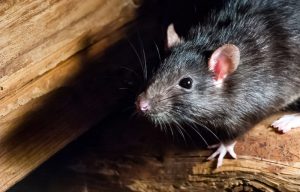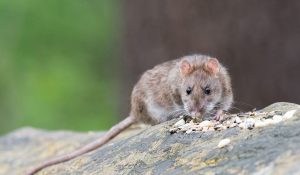Have you seen your yard looking damaged?
You might be dealing with gophers.
These little troublemakers multiply quickly and can destroy your beautiful landscaping in just a few days.
At Smith’s Pest Management, gopher control is our specialty, and we’ve been at it for over 15 years.
In our blog, we’re going to share some of our best advice on how to quickly eliminate gophers on your property.
Key Takeaways
- To get rid of gophers, use traps, baits, repellents, exclusion barriers, and introducing natural predators. Additionally, removing food sources and shelter can deter them.
- Signs of a gopher infestation include horseshoe- or fan-shaped mounds in the soil, plants that have been pulled underground or had their roots chewed off, and bare patches in the yard.
- Gophers reproduce rapidly; young gophers quickly leave the burrow to live alone, and they’re not picky about their food sources. The combination of these factors makes them challenging to eliminate.
What Are Gophers?
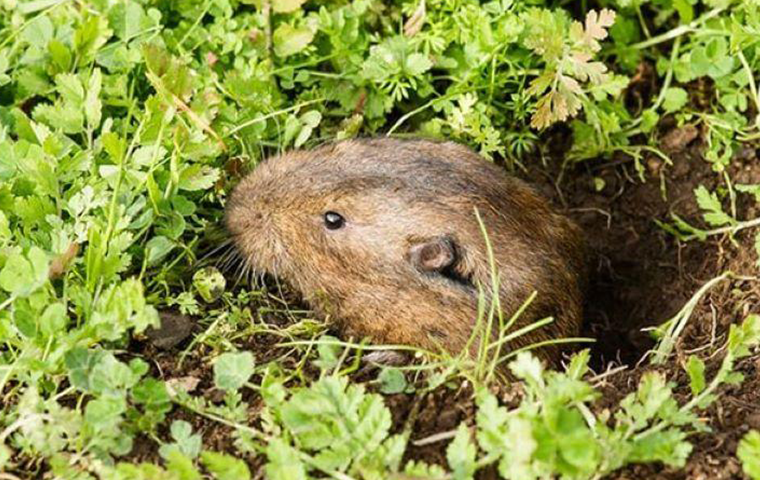
Pocket gophers, or simply gophers, are small, furry rodents that grow to 5-14 inches in length and can weigh a pound or more.
Like mice and voles, gophers are built to dig. They have external, fur-lined cheek pouches that extend to the shoulders and are used to store and transport food.
Their four large incisors grow throughout the gopher’s life and are perfect for chewing through tough, woody plants.
Gophers can close their lips behind those incisors to dig as efficiently as possible and keep the dirt out of their mouths while moving quickly through the ground.
Their small ears and eyes and short, powerful bodies travel efficiently through tunnels while their broad feet and sharp claws work like shovels to move soil.
Although they prefer to live in areas with loose, sandy soil, Gophers are found throughout North and Central America.
When they move into an area, they create an extensive network of burrows and tunnels, where they live, breed, and store food.
What Attracts Gophers?
Humans aren’t the only ones who love a beautiful yard.
Here are a few things that may be drawing gophers to your property:
- Food sources. Gophers need to eat, and they’ll set up shop anywhere they can find food sources. Gophers are herbivores, meaning they only eat vegetation. They love roots and tubers of plants and seeded acorns but sometimes resort to “grazing the lawn for grass, clover, and other snacks.”
- Soil composition. Because gophers love to excavate, they prefer to live in areas with loose, sandy soil that’s easy to move.
- Shelter. Gophers are prey for many other animals, so they need plenty of protection to stay safe.
They may build tunnels under bushes, along fence lines, or under trees. Once you have a few gophers in your yard, the problem will snowball as the gophers reproduce.
What Damage Do Gophers Cause?
Gophers can cause significant damage to both residential and agricultural landscapes.
Their tunneling activity disrupts soil structure, leading to the creation of unsightly mounds and potential harm to the roots of plants and trees.
This can result in weakened vegetation and, in severe cases, the death of plants.
Additionally, gopher tunnels can divert and carry away irrigation water, leading to further stress on landscaping and crops.
Their burrowing can also undermine the integrity of sidewalks, foundations, and other structures, posing risks to human safety and property.
Signs of a Gopher Infestation
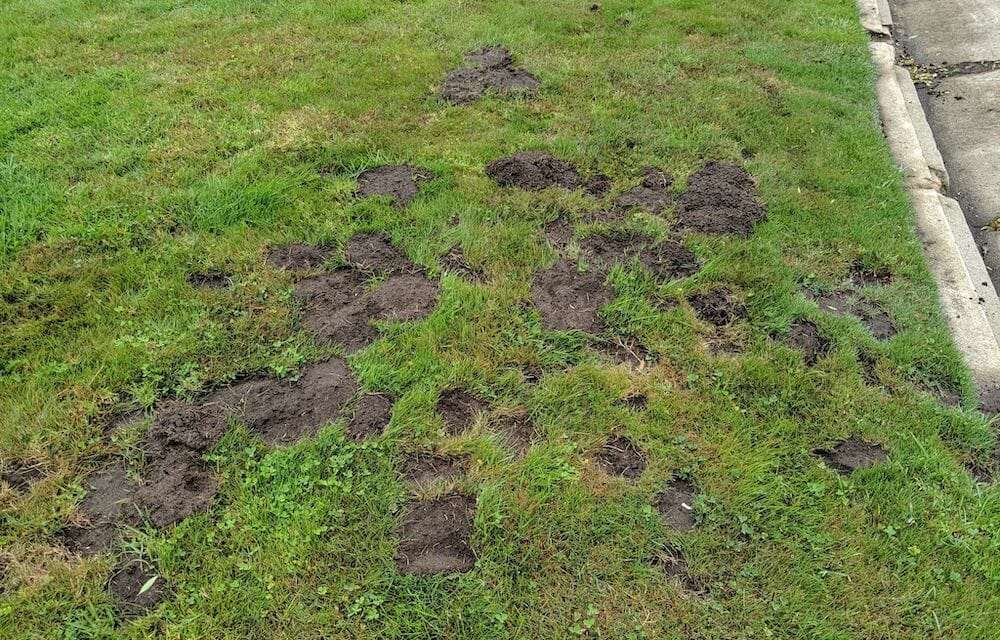
- Mounds. As gophers dig tunnels, they push excess soil to the surface, creating mounds that look like horseshoes or kidney beans. While the mounds can range in size, they all share a few common characteristics: gopher mounds tend to feature dirt that’s been pushed out in a fan pattern, while conical mounds tend to be the work of moles. Gophers also tend to plug their entry holes with fine dirt. Finally, gophers create several holes in close proximity – groups of holes within about six feet of one another are indicative of gopher damage.
- Patches of dried, flat dirt. If you pay a landscaping service to mow and maintain your lawn for you, their machinery may be dispersing gopher mounds. Because of this, you may not actually see the mounds. Instead, you’ll see dried patches of flat dirt that are the result of gopher hills being run over and flattened by the lawn mower. Occasionally, you may also see fresh dirt mounds on top of dried patches. This is evidence that gophers are present and active.
- Damage to crops, gardens, and bushes. Gophers are herbivores, so they’ll eat plants, fruits, and vegetables. If you’ve noticed plant damage like stem girdling and clipping or root exposure caused by burrowing, you can bet that gophers are present.
If you’ve noticed any of the above signs, you need to act fast. Gophers multiply rapidly, and infestations can quickly grow out of control.
Contact a professional pest management company to help you eliminate gophers and reclaim your space.
How to Get Rid of Gophers Like a Pro
With Conventional Methods
1. Traps
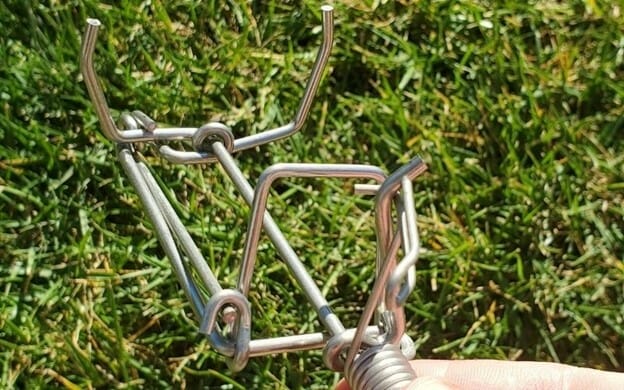
When it comes to gophers, trapping is the best management option.
The major benefit of traps is that you can confirm that the gopher is dead – you know it because you’ve caught it and can see it.
If you poison gophers or use smoke bombs or other tactics, you don’t know for sure that the critter has been eliminated.
Kill traps catch and kill gophers quickly and humanely. At Smith’s, we use commercial-grade stainless steel traps that kill gophers instantly and present a low risk of harm for users.
To find traps that you can use to dispatch gophers on your property, visit a home store or garden center.
For trapping to be effective, you’ll need to find the gophers’ burrows and place traps in or near them.
Here’s how:
- Use a long screwdriver or rebar to push down into the ground in areas of gopher activity. This will allow you to feel where the tunnels are. Active tunnels will be felt as hollow spots in the ground about 2 to 4 inches deep.
- In the area where you located the tunnel, use a small shovel to dig down into the ground, exposing the burrow.
- Once you’ve exposed the underground tunnel system, clean it out – removing all the clods of dirt you knocked in while you were digging.
- Set the trap 6-8” into the tunnel beyond the burrow’s opening – for best results, be sure to set one trap going in each direction.
- Tie a string around your preferred traps and attach them to a stake so that you can locate, check, and remove them quickly.
- Close the burrow up by placing a piece of cardboard or plywood over it. You can also place soil and sod over the opening, as long as you don’t clog the trap with dirt.
- Check the traps in the morning and evening if you prefer. Alternatively, you can let them sit for a few days.
- If gophers haven’t visited the traps within 48 hours, move the traps to a different location in the active area.
- You can set gopher traps all year long since gophers don’t hibernate and are easy to catch in all four seasons. That said, they’re less active during the colder months, so you’ll need to monitor your traps carefully.
- When you check your traps, you may find a gopher still alive in the trap. This is an unfortunate situation, but it’s essential to put the gopher out of its misery swiftly.
- The fastest and most humane way to euthanize a live gopher is to use a shovel to inflict blunt force trauma to the head.
Pros: Effective, rapid solution
Cons: May not be appealing to some people, requires disposal of dead animals, may require euthanasia of live animals
2. Bait
Poisonous gopher bait looks and smells like a tasty treat to gophers.
When gophers consume the substance, though, it kills them quickly.
- Although formulations vary, most baits are made from chemicals like zinc phosphide or anticoagulant rodenticides like warfarin. While Strychnine baits used to be popular, they’re now heavily restricted due to the dangers they present.
- While baits are effective, they require a cautious application. Most are hazardous to kids, pets, and dogs, and some are even outlawed in some places. In California, for example, the rodenticide strychnine is legal but must be placed underground – never at lawn level. Learn more about rodenticide laws in California here.
- Always follow the instructions on the back of the bait’s packaging and use a dispenser probe to deposit the toxins.
- Before you handle any bait, make sure to wear personal protective equipment (PPE), including long pants and gloves. Place all baits directly in gopher burrows and tunnels.
Pros: Effective, fast-acting, good for large gopher populations
Cons: Highly toxic, potential danger for kids, pets, and other non-pest animals, inhumane, dangerous to the environment, can be expensive
Humanely & Naturally
3. Exclusion Fencing

Exclusion fencing keeps gophers away from food sources.
Since gophers, like to feed on roots and tubers, installing exclusion fencing (made from fine metal mesh), can prevent pests from burrowing into vulnerable areas of your lawn or garden or pushing soil to the surface.
You can either place exclusion fencing around areas you want to protect (like the garden), dig a trench and line it or lay stainless steel or galvanized wire mesh beneath your lawn’s sod to deter burrowing.
To successfully exclude gophers, the wire mesh should have openings of less than ½” x 1” (small gophers can fit through 1” openings) and should extend at least 24” underground so gophers can’t burrow beneath it. Ensure your fencing extends above ground so gophers can’t just walk into the area and start digging.
Place your plants in stainless steel or high-quality galvanized steel gopher baskets before planting to protect them. This prevents the gophers from being able to gnaw and destroy their root systems.
To protect trees, make sure to use 15-gallon tree gopher baskets. Unlike other gopher baskets, this option breaks down within a few years, so it doesn’t girdle your tree’s roots.
Note: Do NOT use chicken wire, since it will deteriorate quickly. Instead, buy wire that’s made for gophers and designed to last underground.
Pros: Effective, affordable, humane, long-term solution, poison-free, gets rid of gophers without killing them
Cons: Difficult to install, requires significant modification to existing landscaping
4. Repellents
Repellents are naturally derived or chemical products that make an area unappealing to gophers and force them to go elsewhere.
To use store-bought repellents effectively, place repellents in and around the burrows closest to your home or garden.
A few days later, place additional repellents in burrows further out in your property, extending the repellents closer to the desired exit point. This approach will gradually push the gophers out of your yard.
Note: Repellents are tricky – to effectively repel gophers from their homes (which are underground), you have to saturate the soil with the repellent. This means you have to use a lot of product, apply it liberally, and apply it frequently. Repellents are certainly not a fix, but they can be an option when used in conjunction with other methods. They also have an unknown effect on plants in the garden (they may cause root die-back), and you need to “water them in” enough to be sure they saturate the soil.
Pros: Affordable, humane, non-invasive, safe for kids and pets
Cons: Requires frequent re-application, works best for new landscaping not existing ones
5. Barn Owl Nesting Boxes
Another way to control gopher populations on your property is to construct barn owl nesting boxes.
This isn’t a quick fix, and it won’t eradicate the gophers on your property. It can, however, help control the population of gophers and other pests over time.
Pros: Natural, organic, beneficial for the ecosystem
Cons: Long-term solution, will not eradicate gophers
6. Remove Shelter and Food Sources
Keep the borders of your garden free of weeds. Gophers are less likely to invade your garden if there’s no food to entice them.
Have your lawn treated for earthworms and other gopher food sources, and clean up fallen fruits and vegetables promptly.
Pros: Natural, organic, non-toxic
Cons: Does not kill gophers, will take time to see results
Whatever You Do, Avoid These Methods
1. Flooding
Some people believe that flooding gopher holes will drive the gophers out.
Unfortunately, it only damages your lawn and loosens the dirt under your grass, making it easier for rodents to tunnel through.
Additionally, flooding gopher holes actually enlarges underground tunnels, which can cause sinkholes and massive water waste.
Plus, gophers can just retreat from their burrows until the water recedes, making this method ineffective and inefficient.
2. Live Trapping
While live trapping seems like a humane, effective way to get rid of gophers, it’s practically impossible to do it successfully.
Gophers are naturally hemophiliacs, meaning their blood doesn’t clot effectively, and they can’t heal from being wounded. They’re very fragile creatures that cannot be reliably trapped and relocated.
Even if you were able to move a gopher to a new location, gophers are extremely territorial.
The gopher you relocated would likely get into a terrible battle with other gophers in the territory, causing one or both of them to die, anyway.
3. Fumigating
Fumigation is not a recommended way to get rid of gophers.
In addition to being too involved, costly, and dangerous for amateurs, it’s also complex. For starters, fumigation isn’t just one method.
There’s carbon dioxide fumigation, which requires huge Co2 tanks and expensive equipment to inject it into tunnels; carbon monoxide fumigation, which requires costly machines that use recycled engine exhaust to fill tunnels; smoke bomb fumigation; and more.
The only thing they share in common is that they’re all extremely dangerous and potentially harmful.
If that weren’t bad enough, these methods will not reliably eliminate gophers.
When gas begins to enter underground chambers, gophers can simply move some dirt around to seal themselves in a tunnel and avoid the fumes.
With this in mind, choose safer, more effective pest control methods instead.
4. Scattering pet waste
Although some people will tell you that pet waste scares gophers off, there’s no evidence to support this – so don’t spread your dog’s droppings around.
The same goes for other so-called “home remedies” like human hair and juicy fruit gum – don’t waste your time!
5. Ultrasonic devices
Plain and simple, noisemakers don’t work. We place traps around them all the time, and we can tell you from firsthand experience that they don’t do anything.
6. Gopher-repellent plants
Don’t waste your money on planting a bunch of supposedly “gopher-repellent plants” since there’s no evidence they deter the pests.
7. Castor oil
While many online sources recommend castor oil as a natural repellent, there’s not enough conclusive evidence that it works.
Although it’s been studied as a repellent for moles, there is very little evidence that it’s effective against gophers.
When to Call a Pest Control Pro
If your gopher infestation is severe or not responding to your DIY methods – call a professional.
Because gophers multiply quickly and can cause so much damage so quickly, professional assistance is usually the best way to get rid of these annoying critters.
To eliminate large, well-established populations, a good pest management company will use a variety of strategies, including trapping, baiting, fencing and exclusion, and habitat modification.
A professional exterminator can also help you by providing lots of insider tips and tricks to gopher-proof your property and prevent subsequent infestations.
How Do Exterminators Deal with Gophers?
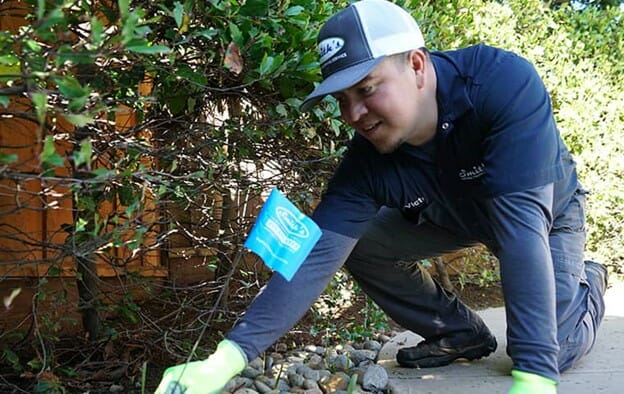
Depending on the severity of the gopher infestation, a professional pest management company like Smith’s will offer the following:
- Trapping. Smiths’ trained pest control experts will locate gopher tunnels, expose a small portion of them, and place professional-grade stainless steel traps inside the tunnel. We’ll cover the trap, mark it with a flag, and return to remove gophers and re-set traps in a few days.
- Carbon monoxide gopher removal. Our trained techs can inject carbon monoxide into the gopher holes if trapping gophers is a concern. This method satisfies Healthy Schools Act requirements and is an excellent solution for daycare centers and schools.
- Annual gopher removal. This is the best way to control gopher populations for the long term. Since gopher infestation can be a recurring problem, Smith’s also offers a yearly gopher removal program. If you enroll in this program, a technician will visit your property every month, adjusting the gopher removal approach accordingly to ensure your yard stays beautiful and gopher-free.
Tips to Keep Gophers Away
- Maintain Your Lawn: Gophers are attracted to overgrown vegetation because it provides them with shelter and food. With this in mind, keep your grass mowed and trim back tall brush and vegetation.
- Use Gopher Mesh: Place trees and shrubs in wire mesh gopher baskets when you plant them. This prevents gophers from being able to access and damage the roots.
- Install Underground Barriers: Installing a hardware cloth or wire mesh fence can help prevent gophers from accessing your garden. The barrier should be at least 18 inches deep and extend a few inches above the ground.
- Employ Natural Predators: Encouraging the presence of natural gopher predators such as owls, hawks, and snakes can help control the gopher population.
- Remove Food Sources: Gophers are attracted to gardens because of the readily available food sources. Cleaning up fallen fruit and vegetables can reduce their food supply and encourage them to find somewhere else to set up shop.
- Regularly Inspect Your Property: Regular inspections can help you detect signs of gopher activity early. Look for fresh mounds of dirt which are a common indicator of gopher presence.
Are Gophers Taking Over Your San Francisco Bay Area Property? We’re Here to Help!
Nobody wants to deal with a destructive, frustrating gopher infestation. Fortunately, Smith’s Pest Management is here for you.
Our team helps residential and commercial properties in Northern California reclaim their outdoor spaces with effective and humane gopher control services.
We also work with parks and large facilities to eradicate gophers in an eco-conscious way.
Call for a free quote today: (408) 871-6988
FAQ
Important safety considerations
For effective and safe DIY gopher control, make sure to adhere to these essential safety protocols:
- Securely store poisonous substances. When using toxic bait for gophers, ensure it is stored in a secure location, preferably a lockable storage area, to prevent access by children, domestic animals, and unintended wildlife. All toxic agents should be clearly labeled.
- Use secure bait stations. Do not scatter bait across your property; always use bait stations designed to prevent tampering. Open distribution of poison can endanger non-target creatures and the environment and pose a hazard to children and pets.
- Carefully read and follow instructions. Always consult and comply with the guidelines provided on the labels of all pesticides and rodenticides. Proper application is crucial for safety and effectiveness.
- Dress for safety. Whenever you handle toxic bait or deal with the aftermath of gopher trapping, such as disposing of carcasses, make sure to wear personal protective equipment (PPE) like gloves.
Do I have a gopher or a mole problem?
The presence of mounds alone isn’t enough to identify gophers since other digging pests create similar damage. For more information, check out one of our previous articles, “How to Identify Gopher Damage in Your Yard,” in which discussed the difference between mole and gopher mounds.
In the meantime, here’s a quick guide to differentiate gopher damage from other burrowing pests:
- Moles: If you’ve noticed long, zigzagging, raised ridges in your lawn and conical mounds, it’s not a gopher – it’s likely a mole. Are you dealing with a mole problem? Check out our other blog here.
- Voles: Another animal that creates similar damage is a vole, which is a small field mouse. They’re usually visible darting around your lawn and will create holes at the edges of your lawn and under your shrubs, but they don’t leave conical mounds of soil.
- Gophers: Only pocket gophers create fan- or horseshoe-shaped mounds of soil when they dig in your lawn. You’ll also notice signs of plant predation, like plants that have been pulled underground or toppled, with their roots chewed off.
It’s important to note that there are some states in the country that call ground squirrels gophers.
For the purpose of this blog, though, we’re talking about the digging pest that closes its hole when it’s done digging and makes horseshoe-shaped mounds.
Gophers feed on underground plant parts and tend to live most of their lives out of sight, while ground squirrels are often visible above ground.
What do gophers hate the most?
Do a quick search for DIY gopher control remedies on the internet, and you’ll come up with many suggestions – from scattering coffee grounds around plants to the options we’ve suggested, like castor oil and ultrasonic spikes.
While DIY methods can effectively complement a more extensive gopher control program, they’re usually not enough to get rid of the pests on their own.
Instead, most homeowners and business owners need to utilize a comprehensive, integrated pest management approach that eradicates existing populations and prevents future infestations.
What is the fastest and easiest way to get rid of gophers?
If you want to get rid of gophers fast, hiring a pest management company that specializes in gopher control (like Smith’s Pest Management) is the best option.
Our team will arrive at your property, evaluate the scope of the infestation, map existing gopher burrows and high-traffic areas, and develop a comprehensive approach to remove them.
This allows you to reclaim your outdoor space faster than DIY methods and to rest assured knowing that your gopher infestation has met its match.
How do I get rid of gophers under my house?
Gophers love a beautiful yard, but they’re also happy to tunnel under the house.
And since a single gopher burrow can extend 200-2,000 square feet and contain 200 yards of tunnels, it’s possible (although unlikely) that gophers under the home can compromise the building’s structural integrity.
Instead, the most serious danger of gophers under the house is that they’ll pile large amounts of soil underneath the house, which will push up into the base of the wood structure and cause problems with termites, dry rot, and moisture-related decay.
If you have gophers under the house, the best solution will be lethal traps or placing gopher baits in the main gopher runways. Whatever you do, never use fumigants under your home.
Implementing these methods can be risky, so it’s wise to contact a skilled pest management company like Smith’s.
Because of the hard-to-reach location of gopher burrows under the house, holistic methods like deterrents are typically ineffective.




